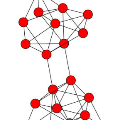Network virtualization (NV) is a technology with broad application prospects. Virtual network embedding (VNE) is the core orientation of VN, which aims to provide more flexible underlying physical resource allocation for user function requests. The classical VNE problem is usually solved by heuristic method, but this method often limits the flexibility of the algorithm and ignores the time limit. In addition, the partition autonomy of physical domain and the dynamic characteristics of virtual network request (VNR) also increase the difficulty of VNE. This paper proposed a new type of VNE algorithm, which applied reinforcement learning (RL) and graph neural network (GNN) theory to the algorithm, especially the combination of graph convolutional neural network (GCNN) and RL algorithm. Based on a self-defined fitness matrix and fitness value, we set up the objective function of the algorithm implementation, realized an efficient dynamic VNE algorithm, and effectively reduced the degree of resource fragmentation. Finally, we used comparison algorithms to evaluate the proposed method. Simulation experiments verified that the dynamic VNE algorithm based on RL and GCNN has good basic VNE characteristics. By changing the resource attributes of physical network and virtual network, it can be proved that the algorithm has good flexibility.
翻译:虚拟网络嵌入(VNE)是VN的核心方向,目的是为用户功能请求提供更灵活的基础物质资源分配基础。古典VNE问题通常通过超自然法解决,但这一方法往往限制算法的灵活性,忽视时限。此外,物理域域的分割自主和虚拟网络请求的动态特性也增加了VNE的困难。本文提出了新型VNE算法,将强化学习(RL)和图形神经网络(GNNN)理论应用于算法,特别是图形共振神经网络(GCNNN)和RL算法的组合。根据自定义的健身矩阵和健身价值,我们设置了算法执行的客观功能,实现了高效的动态VNE算法,并有效地降低了资源分散的程度。最后,我们使用比较算法来评价拟议的方法。模拟实验证实,基于RL和GCNNE的动态VNE算法具有良好的VNE基本特性。通过改变物理网络的资源特性和虚拟网络,证明良好的灵活性是良好的VNEL和虚拟网络。





